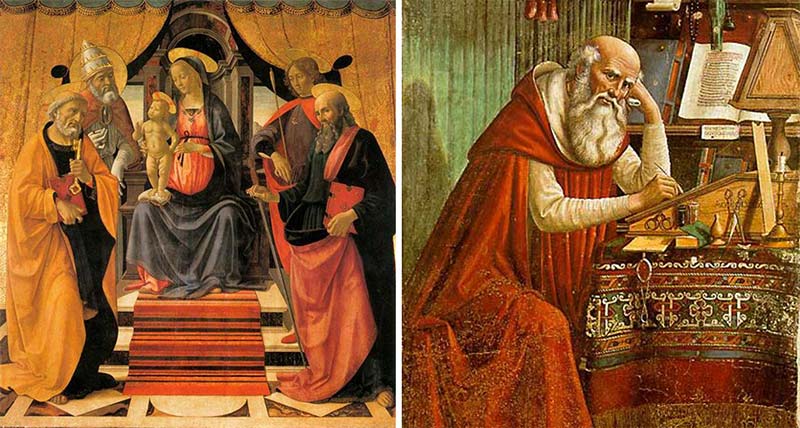Domenico Ghirlandaio was an Italian painter who worked during Renaissance. Born in 1449 as Domenico di Tommaso di Currado di Doffo Bigordi, he was the eldest of his six siblings, from which only three survived to adulthood – the painter himself and his two brothers, Davide and Benedetto. Later on, when his father Tommaso remarried, he sired two other children. At the beginning, Domenico was an apprentice to his father, a goldsmith.
Artist’s nickname, Il Ghirlandaio, came from the fact that Tommaso Bigordi was well-known for creating a garland-inspired headdress, worn by the women of Florence. In his spare time Domenico painted the portraits of clients and visitors who would drop by his father’s shop. Thanks to his immense talent, he was able to paint them with unseen detail and likeness. Such talent could not be wasted, so the young artist soon started his apprenticeship under the Alesso Baldovinetti, early Renaissance painter. There, he was studying the mysteries of mosaic and painting techniques, developing his talent more with each passing day. While Domenico also apprenticed under Andrea del Verrocchio, he also maintained friendship with two other legendary painters, Botticelli and Perugino.
Style-wise, Ghirlandaio was a part of the “third generation” of the Florentine Renaissance painters, along with Verrocchio, Botticelli and Pollaiolo brothers. With his sharp eye, the artist was able to create portraits and compositions which were described as “life-like”, perfectly capturing the spirit of Renaissance life, using religious context. Some claim that Ghirlandaio’s sense of perspective was so accurate that he could easily draw ancient Romanian buildings keeping all the proportions and linear perspective. While the majority of his works was in fresco, he also used tempera. Domenico was skilled in using ” chiaroscuro”, the contrast between light and darkness. His designs were grand in scale and full of elaborate decorations.
Besides being an extremely talented painter, Ghirlandaio was also a great leader. He maintained a successful workshop, where he worked with his brothers and brother-in-law, Bastiano Mainardi and, years later, his own son, Ridolfo Ghirlandaio. One of the things that the painter’s workshop was famous for was the fact that this was the place where legendary Michelangelo had his apprenticeship.

Researchers believe that the Ghirlandaio Type carpets are related to Holbein Type I ones. They both share an abundance of small details and heavy decorations. However, Ghirlandaio carpets usually have one or more central medallions in a shape of a diamond, which consist of an octagonal figure located within a square with triangular patterns arising from its sides. It’s probable that carpets of this style were woven in Western Anatolia, around late 15th or early 16th century, however, there is enough evidence which suggest that similar carpets were also woven in 17th, 18th and 19th.
Domenico’s paintings, which include this particular type of a rug, usually show saints or religious figures. His Madonna and Child enthroned with Saint, painted circa 1483, depicts Virgin Mary with baby Jesus in her arms, surrounded by saints and angels. Her feet are resting on a beautiful piece of weaving craft, which immediately catches the eye. Ghirlandaio’s other work, Saint Jerome in His Study, shows a saint sitting by a table covered with another carpet, kept in a shades of red, green and white. The ornamentations on its surface are rich, as seen in other Ghirlandaio Type carpets.
A rug similar to Ghirlandaio Type ones was found not only in Evangelical church, Hâlchiu in Transylvania, but also in Divriği Great Mosque in Turkey. What’s more, the oriental rugs of this type are still being woven in the Çanakkale region. Their design remained unchanged, showing an unseen continuity of design in that particular region. It seems that the ancient weaving tradition which the artist depicted in his works lives on, allowing us to admire its beauty.